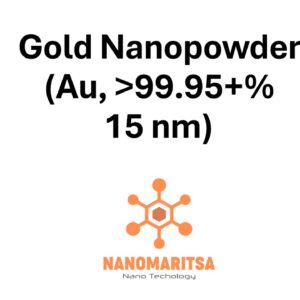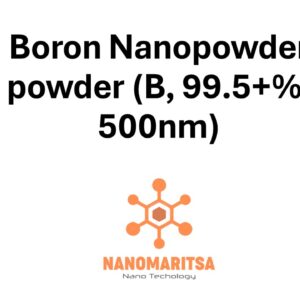Copper Nanopowder (Cu, 99.5%, 800 nm) is a high-purity material with a particle size of 800 nanometers (nm), offering enhanced properties compared to bulk copper. With a purity of 99.5%, this copper nanopowder combines copper’s natural characteristics, such as excellent electrical and thermal conductivity, with the advantages of a nanoparticle form. The 800 nm particle size strikes a balance between increased surface area and material stability, making it suitable for a variety of advanced industrial applications. Below is a detailed overview of its key features, properties, and applications.
Key Features:
Copper (Cu):
Copper is widely recognized for its superior electrical and thermal conductivity, corrosion resistance, and malleability. Copper nanopowder retains these inherent properties while offering a larger surface area, which increases reactivity and material efficiency in various applications, especially in the fields of electronics, catalysis, and coatings.
Purity (99.5%):
The 99.5% purity ensures that the copper nanopowder contains minimal impurities, providing consistent performance in high-demand applications. While slightly lower than some higher-purity variants, the 99.5% purity is still adequate for many industrial processes, offering a balance between cost and performance.
Particle Size (800 nm):
With a particle size of 800 nm, this copper nanopowder exhibits an intermediate surface area, providing improved dispersion and reactivity compared to bulk copper. The larger particle size compared to finer nanopowders makes it easier to handle while still offering sufficient surface area for catalytic and conductive applications.
Properties:
Electrical Conductivity:
Copper is one of the best electrical conductors, and this property is retained in nanopowder form. The copper nanopowder with a particle size of 800 nm is ideal for applications where low resistance and efficient electrical transmission are required, such as in conductive inks for printed circuit boards (PCBs) and flexible electronics.
Thermal Conductivity:
Copper nanopowder continues to exhibit excellent thermal conductivity, making it suitable for applications that require effective heat dissipation. It can be used in thermal interface materials (TIMs), heat exchangers, and cooling systems to ensure efficient heat transfer from heat-sensitive components in electronics and industrial systems.
Corrosion Resistance:
Copper is naturally resistant to corrosion, especially in environments exposed to moisture and chemicals. Copper nanopowder retains this corrosion resistance, making it ideal for use in coatings, alloys, and materials exposed to harsh conditions, such as those found in marine, industrial, and chemical environments.
High Surface Area:
With a particle size of 800 nm, this copper nanopowder offers a moderate increase in surface area compared to bulk copper, enhancing its reactivity for catalytic processes. The increased surface area also contributes to better dispersion when incorporated into composite materials, improving the overall properties of the final product.
Malleability and Ductility:
Copper’s inherent malleability and ductility are preserved in its nanopowder form, allowing it to be easily incorporated into composites or processed into thin films. This property is essential for applications requiring flexibility or material shaping, such as in flexible electronics and coatings.
Chemical Stability:
Copper nanopowder is chemically stable and resistant to degradation in most environments. This stability allows it to perform reliably in a wide range of industrial and scientific applications, including those in high-temperature or chemically reactive environments.
Applications:
- Electronics and Conductive Inks:
Copper nanopowder is widely used in the electronics industry for conductive inks in printed circuit boards (PCBs), flexible electronics, and sensors. The high electrical conductivity of the copper nanopowder ensures efficient electrical transfer, which is essential for the performance of electronic devices. - Energy Storage and Batteries:
Copper nanopowder is used in energy storage systems, such as lithium-ion batteries and supercapacitors. Its increased surface area and electrical conductivity improve the charge and discharge cycles, leading to better overall performance and efficiency in energy storage applications. - Catalysis and Chemical Synthesis:
Copper nanopowder is a highly effective catalyst for a variety of chemical reactions, such as hydrogenation, oxidation, and polymerization. Its increased surface area enhances catalytic efficiency, making it suitable for industrial processes such as fuel production, fine chemicals, and environmental applications for pollutant removal. - Thermal Management and Heat Dissipation:
Due to copper’s excellent thermal conductivity, copper nanopowder is used in thermal management applications, such as thermal interface materials (TIMs), heat exchangers, and cooling systems. It helps effectively dissipate heat from sensitive components in electronics, automotive systems, and industrial machinery. - Coatings and Plating:
Copper nanopowder is used in electroplating and coatings, providing enhanced conductivity and corrosion resistance. It is applied in industries such as automotive, aerospace, and manufacturing, where high-performance coatings are necessary to prevent wear and corrosion of metal components. - Composites and Additives:
Copper nanopowder is incorporated into composite materials to enhance their electrical and thermal conductivity. It is particularly useful in industries such as automotive, aerospace, and electronics, where lightweight, high-performance materials are required for components like electric vehicle batteries, sensors, and aerospace parts. - Solar Cells and Photovoltaic Applications:
Copper nanopowder is increasingly used in solar energy applications. Its excellent electrical conductivity is beneficial for the production of conductive layers and electrodes in thin-film solar panels, helping to improve the overall efficiency of solar energy conversion. - Antibacterial and Antimicrobial Applications:
Copper has inherent antimicrobial properties, and copper nanopowder is used in medical devices, wound care, and water purification systems. It is effective in reducing bacterial and viral growth, making it valuable in healthcare settings where infection control is critical.
Handling and Safety:
Health and Safety Considerations:
Copper nanopowder should be handled with care to avoid inhalation, ingestion, or prolonged skin contact. Proper personal protective equipment (PPE), such as gloves, masks, and safety goggles, should be used when working with copper nanopowder. It is important to work in a well-ventilated area to minimize the risk of inhaling airborne particles.
Storage:
Copper nanopowder should be stored in a cool, dry, and well-ventilated area to prevent moisture and oxidation, which could degrade the material’s performance. The container should be tightly sealed to protect the powder from exposure to air and humidity, ensuring its stability and effectiveness.
Precautions:
When handling copper nanopowder, avoid generating dust or aerosols. It is recommended to work in a controlled environment, such as a fume hood, to minimize inhalation risks. Always dispose of the material according to local environmental regulations to ensure safe handling and minimize environmental impact.
Summary:
Copper Nanopowder (Cu, 99.5%, 800 nm) is a high-purity material that combines copper’s excellent electrical and thermal conductivity with the benefits of nanoparticle form, such as increased surface area and enhanced reactivity. With a moderate particle size of 800 nm, this copper nanopowder is ideal for a wide range of applications, including electronics, energy storage, catalysis, thermal management, and coatings. Its corrosion resistance, stability, and high performance make it valuable in diverse industrial and scientific fields. Proper handling, storage, and safety precautions are essential to maintain the material’s effectiveness and ensure safe use.
| Measurement (gr) | 100 grams, 500 grams, 1000 grams |
|---|






